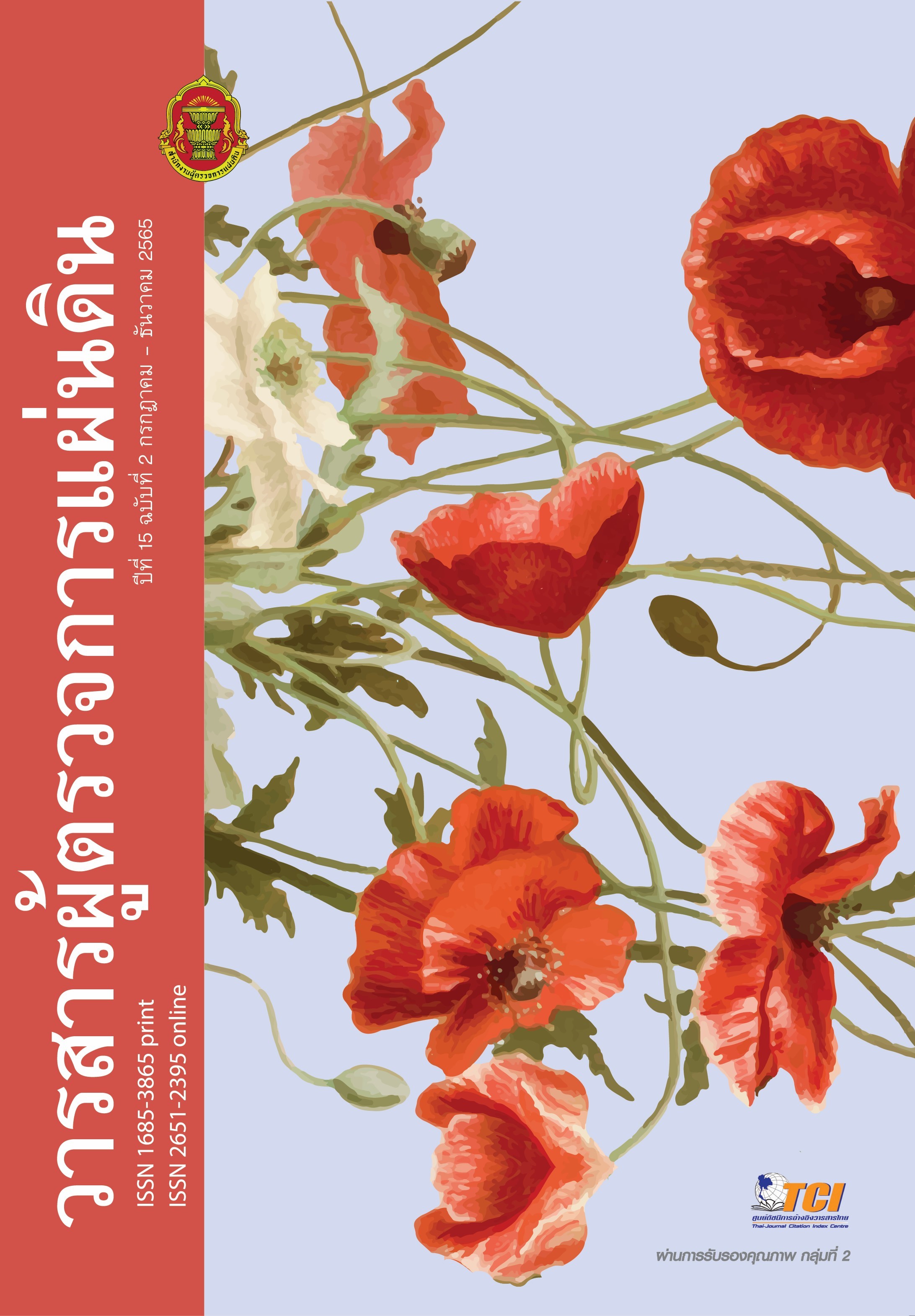Success Factors of Argentina Tracking the Missing during the Dirty War
-
Keywords:
identification, missing Person, unidentified remainsAbstract
The purpose of the academic article was to study the success factors of Argentina in tracking the missing during the Dirty War to adapt to the Thai context including the study of factors that contributed to the success of Argentina in tracking the missing guidelines for developing success in tracking missing persons and unidentified bodies. Although the context of the disappearance problem and unidentified bodies between Argentina and Thailand are different in terms of the techniques and methodology for tracking the missing person identification of unidentified bodies in Argentina can be adapted to suit the context of Thailand.
This article presents the success factors in tracing missing persons and unidentified bodies in Argentina including the national policies, the Royal Decrees on Amnesty and Pardon, the People's Movements and Calls, and international support, and leads to suggestions for improving success in tracking the missing and unidentified bodies in Thailand as follows: Policy and Goals Datacenter integration of missing persons and unidentified bodies interagency cooperation and legal development.
References
Calatrava almudena. (2019) [Argentina: Bodies of 600 disappeared wait to be identified ].
AP.NEWS.
Catoggio, María Soledad .(2020). [Religion, Human Rights, and Forensic Activism: The Search for
the Disappeared in Latin America †]. MDPI, 11., 601, 1-17.
Central Institute of Forensic Science. (2022). Work Instructions on unidentified bodies and
unclaim bodies.
Central Institute of Forensic Science. (2021). Statistics of missing persons and unidentified bodies
since 2018-2022.
Chaowarit Chaosangrat. (2021). [Killer State: A Case Study of the Dirty War in Argentina from
- 1983]. (5, July, 2022). Retrieved from https://www.the101.world/argentina-state-killings/
Cross Cultural Foundation. (2021). (28, June, 2022). Retrieved from https://crcfthailand.org/
David Pérez-Torres, Pedro & Congram, Derek. (2020). [Biography of the Equipo Argentino de
Antropología Forense (EAAF)]. Forensic Anthropology, 5.,3, 262–266.
The Argentine Forensic Anthropology Team.(2003). [EAAF 2003 ANNUAL REPORT]. (8, May, 2022).
Retrieved from https://eaaf.org/wp-content/uploads/2018/08/argentina2003.pdf
The Argentine Forensic Anthropology Team. (2007). [EAAF 2007 ANNUAL REPORT]. (8, May, 2022).
Retrieved from https://www.yumpu.com/en/document/read/33870543/liid-eaaf
The Argentine Forensic Anthropology Team. (2021). [Equipo Argentino de Antropologia
Forense]. (16, August, 2022). Retrieved from https://eaaf.org/quienes-somos/
The Argentine Forensic Anthropology Team. (n.d.). [Equipo Argentino de Antropologia Forense
(EAAF)]. (16, August, 2022). Retrieved from https://eaaf.org/enobras/#
Fondebrider Luis. (2020). [Forensic Guide to the Investigation, Recovery and Analysis of Human
Skeletal Remains]. Argentina: Argentine Forensic Anthropology Team (EAAF).
Fowler & Thompson. (2015). [A mere technical exercise? Challenges and technological solutions
to the identification of individuals in mass grave scenarios in the modern context]. In Jean-Marc Dreyfus & É lisabeth Anstett ( Ed.), [Human remains and identification] (pp. 117-141) England: Manchester University Press.
Guerriero Leila. (2021). [The Trace in the Bones]. (8, May, 2022). Retrieved from
https://www.asymptotejournal.com/nonfiction/leila-guerriero-the-trace-in-the-bones/
I'm from Andromeda. (2021). [อาร์เจนตินาในยุคเผด็จการปี 1978 กับการจัดฟุตบอลโลกที่ปิดบังความชั่วร้าย
ของรัฐบาลฆาตกร]. (9, August, 2022). Retrieved from https://thematter.co/thinkers/argentina-world-club-1978/149439
Lourdes, Ramirez. (2021). Forensic Anthropology in Latin America: Examining Methods of Human Identification. (5, May, 2022). Retrieved from https://www.csustan.edu/sites/default/files/groups/University%20Honors%20Program/ Journals_two/ramirez_lourdes_.pdf
Mallinder,Louise. (2009). [The Ongoing Quest for Truth and Justice: Enacting and Annulling Argentina's Amnesty Laws]. UK: Queen's University, Belfast.
New Tactics and Center for Victims of Torture. (n.d.). Using forensics to identify victims’ remains and cause of death. (25, May, 2022). Retrieved from https://www.newtactics.org/tactic/using-forensics-identify-victims%E2%80%99-remains-and-cause-death
Phakwadee Weeraphaspong. (2010). [Transitional Justice: A Case Study of Argentina]. (25, June,2022). Retrieved from https://prachatai.com/journal/2010/11/31728
Rachadaporn Mornmoung. (2021). [Practical problems of The Regulation of the Office of the Prime Minister on Search of Missing Persons and Identification of Unidentified Persons and Unidentified Remains B.E. 2564]. Constitutional Court Journal, 23., 69,198-223.
Rachadaporn Mornmoung & Sarit Suebpongsiri. (2021). [A Model of Databases Missing Persons and Unidentified Bodies in Thailand]. Journal of Criminology and Forensic Science, 7., 7, 55-70.
Robins, S. (2019). [Analysis of Best Practices on the Identification of Missing Migrants: Implications for the Central Mediterranean]. Geneva: International Organization for Migration.
Royal Thai Police. (2015). Order of the Royal Thai Police no. 725/2558 Subject: Missing Persons Management Center (MPMC) Royal Thai Police. (25, May, 2022). Retrieved from http:// www.criminal.police.go.th/documents/ INF25581228.pdf
The Mirror Foundation and others. (2009). [Children's Tracking and Prevention Guide]. Bangkok: The Mirror Foundation
The Mirror Foundation. (n.d.). (28, June, 2022). Retrieved from http://web.mirror.or.th/aboutmirrorf.php?m=about
The Prevention and Suppression of Torture and Enforced Disappearance Act B.E.2565 (2022). (25, Oct, 2022). Government Gazette/139/66 ก/43-57.
Wallenfeldt, Jeff. (n.d.). [Dirty War Argentine history]. (22, July, 2022). Retrieved from https://www.britannica.com/event/Dirty-War
Zagorski, Paul W.(1994). [Civil-Military Relations and Argentine Democracy: The Armed Forces under the Menem Government]. JSTOR, 20.,3,423-437.
Downloads
Published
How to Cite
Issue
Section
License
Copyright (c) 2022 Office of the Ombudsman

This work is licensed under a Creative Commons Attribution-NonCommercial-NoDerivatives 4.0 International License.
- Content published in the journal is personal opinions of authors which the office of Ombudsman and the editorial team are not bound to be accordance with.
- Articles, content, images, etc. published in the Journal of Ombudsman are copyright of the Journal. If any person or entity wants to bring all or part of it to publish or to do any action. Must obtain written permission from the journal's first.



